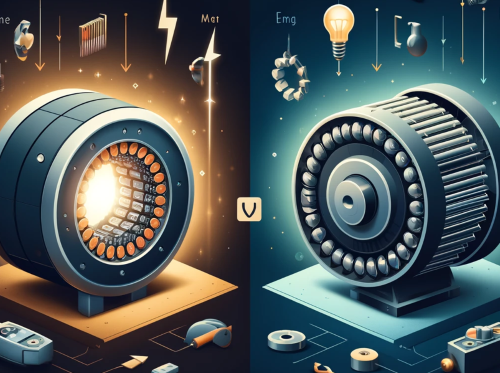Permanent Magnet vs. Electromagnetic Generators
Introduction
In the evolving landscape of power generation, the debate between permanent magnet generators (PMGs) and electromagnetic generators (EMGs) is central to discussions about efficiency, reliability, and applicability in various settings. Both technologies have their unique advantages and drawbacks, and understanding these can help in selecting the appropriate generator type for specific applications.

This article provides a comparative analysis of PMGs and EMGs, exploring their operational principles, performance characteristics, and suitability for different uses.
Operational Principles
Permanent Magnet Generators utilize permanent magnets to generate a magnetic field. This eliminates the need for an external power source to excite the generator, unlike in electromagnetic generators. The magnetic field is constant, provided by the inherent properties of the magnets used, typically made from rare earth elements.
Related Reading: What are the Benefits of Permanent Magnet Generators?
Electromagnetic Generators, on the other hand, rely on electromagnets for their magnetic field. This requires an external electrical source to “excite” the generator’s coils, producing the magnetic field necessary for operation. This design is traditional and has been used in power generation for more than a century.
Performance Characteristics
- Efficiency: PMGs are generally more efficient than EMGs, particularly at lower speeds. This is due to the constant magnetic field provided by permanent magnets, which does not require energy to maintain. EMGs, however, can lose efficiency because they need continuous power to the electromagnet for the generation process.
- Cost and Maintenance: The initial cost of PMGs can be higher than EMGs due to the expense of rare earth magnets. However, PMGs often have lower operational and maintenance costs since they have fewer moving parts and do not require electricity to maintain their magnetic field. EMGs might need more maintenance due to wear and tear on the components that energize the electromagnets.
- Reliability and Lifespan: PMGs are considered more reliable and have a longer lifespan compared to EMGs. This is attributed to their simpler construction and the absence of the need for continuous electrical supply to the magnetic field. EMGs’ reliability can be compromised over time due to the potential degradation of the coil insulation and other components involved in field excitation.
- Power Output: EMGs can offer a broader range of power output control since their magnetic field can be adjusted by varying the current supplied to the electromagnet. This makes EMGs versatile for applications requiring a wide range of power outputs. PMGs have a fixed magnetic field strength, which can limit flexibility in controlling output but makes them highly efficient within their optimal operating range.
Suitability for Various Applications
- Renewable Energy Systems: PMGs are increasingly favored in renewable energy applications, such as wind turbines and hydroelectric generators, due to their high efficiency at variable speeds and lower maintenance requirements. Their compact size and higher power density make them suitable for these applications where space and reliability are critical.
- Large-scale Power Generation: EMGs are traditionally used in large-scale power plants due to their capability to produce a wide range of power outputs and the ease of controlling their output. They are well-suited for applications that require large amounts of electricity and where the generator’s size and cost are less of a concern.
- Automotive and Aerospace: PMGs are becoming more common in automotive and aerospace applications, including hybrid and electric vehicles, due to their efficiency, reliability, and compact size. Their ability to operate efficiently at various speeds makes them ideal for these dynamic environments.
- Industrial Applications: Both PMGs and EMGs find their place in industrial applications, but the choice depends on specific needs such as power output, efficiency requirements, and operational conditions. EMGs might be preferred in situations where output control is crucial, while PMGs could be chosen for their efficiency and reliability.
Conclusion
The choice between permanent magnet and electromagnetic generators is not a one-size-fits-all decision. It requires a thorough understanding of the operational environment, efficiency needs, cost implications, and maintenance capabilities.
PMGs offer high efficiency, reliability, and lower maintenance needs, making them suitable for renewable energy applications and compact systems where these characteristics are valued. EMGs, with their flexible power output and traditional design, continue to play a crucial role in large-scale power generation and applications requiring variable power output.
As technology advances, the development of new materials and designs may further blur the distinctions between these two types of generators, potentially leading to hybrid systems that combine the best features of both. Thank you for reading this article. Since the 1990s, Stanford Magnets has been at the forefront of magnet research and development, providing top-tier permanent magnets. For comprehensive details, please visit our homepage.
| Characteristic | Permanent Magnet Generators (PMGs) | Electromagnetic Generators (EMGs) |
| Operational Principle | Utilize permanent magnets to create a constant magnetic field without external power. | Rely on electromagnets, requiring external power to excite the generator’s coils. |
| Efficiency | Generally more efficient, especially at lower speeds due to constant magnetic field. | Can lose efficiency as they require continuous power for the magnetic field generation. |
| Cost and Maintenance | Higher initial cost due to rare earth magnets but lower operational and maintenance costs. | Lower initial cost but potentially higher maintenance needs due to component wear. |
| Reliability and Lifespan | More reliable and longer lifespan attributed to simpler construction and no need for continuous electricity. | Reliability may decrease over time due to potential degradation of components. |
| Power Output | Fixed magnetic field strength limits output flexibility but offers high efficiency within optimal range. | Adjustable magnetic field allows for a broader range of power output control. |
| Suitability for Applications | Preferred in renewable energy, automotive, and aerospace for their efficiency and compact size. | Used in large-scale power generation and industrial applications requiring variable power output. |